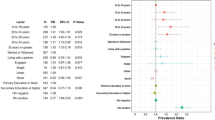Abstract
Background
Up to two-thirds of individuals acquire herpes asymptomatically and most infected persons shed the virus during latency periods. Genital infection is frequently associated with the presence of other sexually transmitted diseases. The objective of this paper was to assess the seroprevalence of HSV-2 in a low risk population and to validate the use of reported symptoms and clinical signs as a possible diagnostic tool to screen for HSV-2.
Methods
One hundred and fifty consecutive women presenting for the first time to the Gynecology outpatient clinic with complaints of vaginal discharge, lower abdominal pain, genital warts or ulcers were enrolled over a period of 4 months. Samples were taken and laboratory tests were performed to evaluate the presence of common reproductive tract infections including HSV-2.
Results
In this study, using a validated type specific assay, we found an unexpected high prevalence of HSV-2 (35 subjects, 23.3%). Of the 147 women who presented with the symptom of vaginal discharge, 34 (23.1%) tested positive for HSV-2. On examination cervical erosion and tenderness was noted in 50 women, in 23 (46%) of whom HSV-2 tested positive. On univariate analysis, no significant association was found between selected demographic factors, STIs and NSTIs and HSV-2. The association between previous abortion and HSV-2 was however, statistically significant. Also, none of the women who had HSV-2 positivity tested positive for HIV.
Conclusion
The high HSV-2 seroprevalence in this low risk population may indicate a high risk for future acquisition of HIV in this population. Cervical erosion and hypertrophy as a possible clinical marker for HSV-2 has low positive predictive value and cannot be recommended as a possible diagnostic tool to screen for HSV-2 in resource poor settings.
Similar content being viewed by others
References
Nilsen A, Myrmel H (2000) Changing trends in genital herpes simplex virus infection in Bergen, Norway. Acta Obstet Gynecol Scand 79:693–696
Gibson J, Hornung C, Alexander G et al (1990) A cross-sectional study of herpes simplex virus type 1 and 2 in college students: occurrence and determinants of infection. J Infect Dis 162:306–312
Stamm WE, Handsfield HH, Rompalo AM, Ashley RL, Roberts PL, Corey L (1988) Association between genital ulcer disease and acquisition of HIV infection in homosexual men. J Am Med Assoc 260:1429–1433
Baringer JR (1974) Recovery of herpes simplex virus from human sacral ganglions. N Engl J Med 291:828–830
Cowan FM, French RS, Mayaud P et al (2003) Seroepidemiological study of herpes simplex virus types 1 and 2 in Brazil, Estonia, India, Morocco, and Sri Lanka. Sex Transm Infect 79:286–290
Corey L, Handsfield HH (2000) Genital herpes and public health—addressing a global problem. JAMA 283:791–794
Wasserheit J (1992) Epidemiological synergy: interrelationships between human immunodeficiency virus infection and other sexually transmitted diseases. Sex Transm Dis 19:61–77
Nahmias AJ, Roizman B (1973) Infection with herpes-simplex viruses 1 and 2. N Engl J Med 289:667–674
Corey L, Spear PG (1986) Infections with herpes simplex viruses. N Engl J Med 314:686–691
Prober CG, Corey L, Brown ZA et al (1992) The management of pregnancies complicated by genital infections with herpes simplex virus. Clin Infect Dis 15:1031–1038
Frenkel LM, Garratty EM, Shen JP, Wheeler N, Clark O, Bryson YJ (1993) Clinical reactivation of herpes simplex virus type 2 infection in seropositive pregnant women with no history of genital herpes. Ann Intern Med 118:414–418
Wald A, Zeh J, Barnum G, Davis LG, Corey L (1996) Suppression of subclinical shedding of herpes simplex virus type 2 with acyclovir. Ann Intern Med 124:8–15
Sacks SL, Aoki FY, Diaz-Mitoma F, Sellors J, Shafran SD (1996) Patient-initiated, twice-daily oral famciclovir for early recurrent genital herpes: a randomized, double-blind multicenter trial. JAMA 276:44–49
Slomka MJ, Ashley RL, Cowan FM et al (1995) Monoclonal antibody blocking tests for the detection of HSV-1 and HSV-2 specific humoral responses: comparison with western blot assay. J Virol Meth 55:914–920
Mullan HM, Munday PE (2003) The acceptability of the introduction of a type specific herpes antibody screening test into a genitourinary medicine clinic in the United Kingdom. Sex Transm Infect 79:129–133
Roest RW, van der Meijden WI, van Dijk G et al (2001) Prevalence and association between herpes simplex virus types 1 and 2-specific antibodies in attendees at a sexually transmitted disease clinic. Int J Epidemiol 30:580–588
Siegel D, Golden E, Washington AE et al (1992) Prevalence and correlates of herpes simplex infections: the population-based AIDS in multiethnic neighborhoods study. JAMA 268:1702–1708
Breinig MK, Kingsley LA, Armstrong JA et al (1990) Epidemiology of genital herpes in Pittsburgh: serologic, sexual, and racial correlates of apparent and inapparent herpes simplex infections. J Infect Dis 162:299–305
Cowan FM, Johnson AM, Ashley R et al (1994) Antibody to herpes simplex virus type 2 as serological marker of sexual lifestyle in populations. BMJ 309:1325–1329
Wald A, Koutsky L, Ashley RL et al (1997) Genital herpes in a primary care clinic: demographic and sexual correlates of herpes simplex type 2 infections. Sex Transm Dis 24:149–155
Tideman RL, Taylor J, Marks C et al (2001) Sexual and demographic risk factors for herpes simplex type 1 and 2 in women attending an antenatal clinic. Sex Transm Infect 77:413–415
WHO and UNAIDS (2001) Herpes simplex virus type 2: programmatic and research priorities in developing countries. Report of a WHO/UNAIDS/LSHTM workshop. London, WHO/HIV_AIDS/2001.05. 2001
Acknowledgment
The authors are grateful to the department of Community Medicine for help with the statistical analysis. Conflict of interest: none.
Author information
Authors and Affiliations
Corresponding author
Rights and permissions
About this article
Cite this article
Maitra, N., Gupta, M. Seroprevalence and correlates of herpes simplex virus type-2 infection in a general gynecology clinic. Arch Gynecol Obstet 275, 19–23 (2007). https://doi.org/10.1007/s00404-006-0207-2
Received:
Accepted:
Published:
Issue Date:
DOI: https://doi.org/10.1007/s00404-006-0207-2




